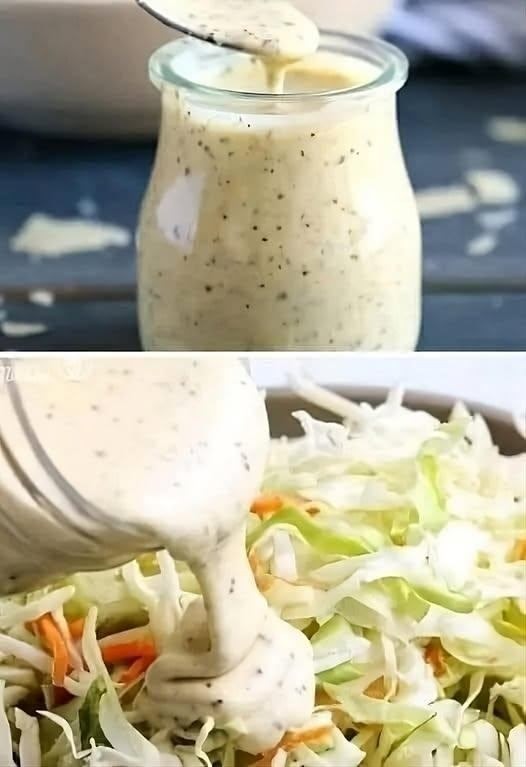ADVERTISEMENT
Some of the most popular store-bought dressings, like ranch, Italian, and balsamic vinaigrette, can be loaded with unnecessary ingredients like sugar, preservatives, and artificial flavors. Homemade dressings, on the other hand, can be tailored to suit individual tastes and dietary restrictions, with the added benefit of knowing exactly what goes into the dressing.
However, one of the common challenges with homemade dressings is their relatively short shelf life. Most homemade dressings will last for about 1-2 weeks in the fridge due to their perishable ingredients, such as dairy or fresh herbs. But what if there was a way to create a dressing that was quick to make, better than restaurant dressings, and lasted much longer?
### **The Basics of Salad Dressing**
Before we dive into the recipe, let’s first discuss the basic components of most salad dressings. Understanding these ingredients will help you make better decisions when customizing your dressing, as well as give you an understanding of why certain dressings last longer than others.
#### **1. Oil**
Oil is one of the most essential ingredients in any salad dressing. It serves as the base and helps to create a creamy texture, especially when emulsified with other ingredients. The most commonly used oils in salad dressings are olive oil, vegetable oil, and avocado oil. Olive oil is often preferred because of its robust flavor and healthy fats. However, for dressings that need to last longer, lighter oils like sunflower oil or grapeseed oil can be used.
#### **2. Acid**
Acidity is key to balancing the richness of the oil. The most common acids used in salad dressings are vinegars and citrus juices. **Vinegar** (especially balsamic, red wine, or apple cider) brings tanginess, while **lemon juice** or **lime juice** adds a fresh citrusy punch. The balance between the oil and acid is crucial to creating a dressing that tastes vibrant and balanced.
#### **3. Sweetener**
Sweeteners help round out the flavors in a salad dressing, balancing the acidity and saltiness. Common sweeteners include honey, maple syrup, and agave nectar. For a sugar-free version, you can also use natural sweeteners like stevia or monk fruit.
#### **4. Emulsifiers**
Some dressings require emulsifiers to bring the ingredients together. **Dijon mustard** is often used because it has a natural emulsifying property. Other ingredients like egg yolk or honey can also serve as emulsifiers. Emulsifiers help the oil and vinegar (or acid) blend together and remain stable over time, ensuring that your dressing doesn’t separate when stored.
#### **5. Seasonings and Flavorings**
Salt, pepper, garlic, shallots, herbs, and spices are essential to enhancing the flavor profile of your dressing. Depending on your preferences, you can also add extras like **fresh or dried herbs**, **garlic powder**, **onion powder**, or even a small splash of **soy sauce** or **Worcestershire sauce** for added complexity.
### **A Salad Dressing with Virtually Unlimited Shelf Life**
Now that we understand the basics of salad dressings, let’s dive into the recipe for a quick, homemade dressing that’s better than restaurant versions and has a shelf life of months.
#### **The Secret Ingredient: Vinegar and Salt Preservation**
The secret to creating a salad dressing that lasts for months is to utilize vinegar as the primary acid component and salt as a preservative. Both vinegar and salt have natural preserving qualities that help extend the shelf life of the dressing without the need for refrigeration. When combined with the right balance of oil and emulsifiers, the dressing can remain stable and safe to eat for months.
### **Quick Salad Dressing Recipe**
**Ingredients:**
– 1 cup **olive oil** (or any neutral oil of your choice)
– ½ cup **vinegar** (apple cider vinegar, balsamic vinegar, or red wine vinegar work best)
– 2 tablespoons **Dijon mustard** (for emulsification and flavor)
– 1-2 tablespoons **honey** (or maple syrup for a vegan version)
– 1 teaspoon **salt** (use sea salt or kosher salt for best results)
– ½ teaspoon **black pepper**
– Optional: 1 tablespoon **fresh or dried herbs** (such as oregano, basil, or thyme)
– Optional: 1 teaspoon **garlic powder** or 1-2 cloves of fresh garlic (minced)
**Instructions:**
1. **Combine the Ingredients:**
In a jar or a bowl, add the Dijon mustard, vinegar, salt, pepper, and honey (or maple syrup). If you’re using fresh garlic or herbs, add them now as well.
2. **Whisk Together or Shake:**
Whisk the ingredients together to combine. If you’re using a jar, you can simply screw the lid on and shake the ingredients together. The mustard will act as an emulsifier, helping the oil and vinegar blend together.
3. **Slowly Add Oil:**
Gradually pour in the olive oil while continuously whisking (or shaking if using a jar). The oil should be added slowly to allow the dressing to emulsify and thicken. If you want a thinner dressing, you can add less oil.
4. **Taste and Adjust:**
Once the dressing is well-mixed, taste it and adjust the seasoning. You can add more honey for sweetness, more vinegar for acidity, or extra salt and pepper to taste.
For Complete Cooking STEPS Please Head On Over To Next Page Or Open button (>) and don’t forget to SHARE with your Facebook friends
